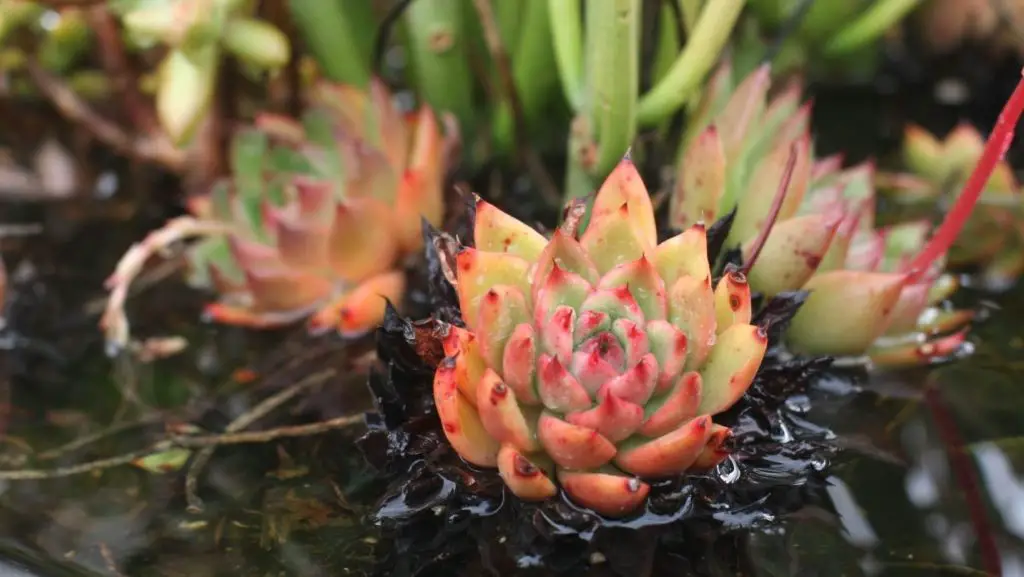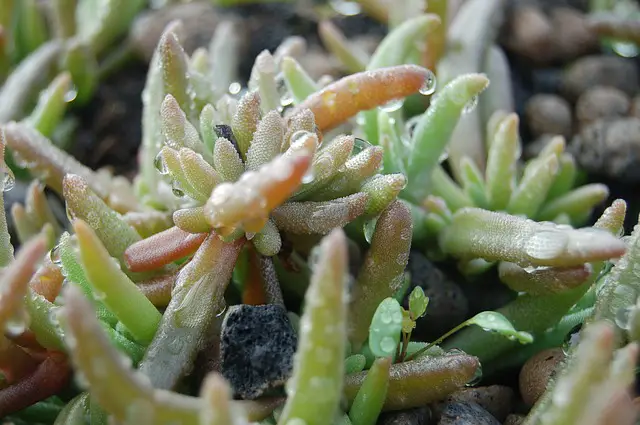Picture this: Your outdoor succulents are thriving. You have your plant care in the bag. You know the balance between overwatering and underwatering, temperature and humidity control, and you have successfully made your succulent haven with little to no shortcomings.
When everything seemed perfect, it hit. Rain. Rain. Rain.
The gloomy, wet variable that throws it all off. So how much does monsoon rain on your parade? Is it necessary to shelf your succulents in that case? Should you bring your succulent inside when it rains?
The answer actually depends on your climate, the garden’s location, temperature, drainage system, etc.
Should You Bring Your Succulent Inside when it Rains?
Rain can actually be highly nutritious for your succulents, even the ones that are cacti. Your prickly, leafy friends enjoy a good soak of fresh rainwater every now and then.
Unlike your tap water, rainwater is pure with no additives that may disturb your succulent’s ideal conditions. A little rain is excellent to restore any wilting or damage to your plants.
The problem with rain and succulents is hardly the water. Your chosen method to deal with the excess moisture will decide the fate of your plants.

Effect of Rain on Succulents
A drizzle does wonders for your succulents, sometimes so does heavy rainfall. Not only is rainwater the best form of hydration for your plants, but it also acts as a cleansing shower for both the succulents themselves and the soil they’re planted in. Any residual mineral build-up is diluted and their effect is mostly neutralized. It is the most preferred choice for many gardeners in terms of choice of water.
The leaves of your green companions are washed clean of dirt and dust, which gives them better access to sunlight. Rainwater also provides ample nitrogen, which is a common ingredient in fertilizers. This is why your garden is likely to appear vibrant and fresh sometime after rainfall.
As obscure as it might sound, thunderstorms nourish plants. Both rainwater and lighting contain nitrates. The nitrates seep into the soil and can be absorbed by plants, preparing them for a growth spurt.
So far, you might have heard that moisture is the devil. While it still holds true, the reason your succulents hate excess water so much is due to their structure and function. Succulent leaves are meant to retain moisture so that they can survive the harsh elements.
Succulents are more likely to survive a dry spell compared to a damp environment. Rain would mean too much pooling around the plants. Succulents don’t necessarily dislike water, the problem occurs when you leave them in it.
Excess water results in the leaves absorbing that much moisture until they reach past their limit. You will notice the leaves plump up and eventually, they will burst.
Properly mitigating the pooling and puddling of water erases most of the threats to your garden during the monsoon season.
Could Rain Kill Succulents
Rain can easily and quickly lead to overly wet garden soil. Overwatering is up there in the list of most common mistakes people make with succulents. Since their leaves function as water storage, the leaves are damaged when they absorb water past their capacity.
While rain won’t kill the succulents, it can still set your progress back significantly. Moist areas are perfect festering grounds for fungal or bacterial diseases. Water gathered at the roots can cause drowning and rotting.
These can be common struggles for both potted plants as well as ones installed in the ground.
Should You Keep Them Indoors
If you’ve had continuous rain, it might be wise to bring your succulents indoors. There isn’t much reason to move your succulents when they are appropriately protected. Your succulent is a pretty resilient little guy.
You will need to watch out for humidity and temperature, the height of the rain, your drainage system, and rain protection and make that decision based on these factors.
Where you put them to protect them from the rain is mostly irrelevant, as long as it is done right.
If it is inconvenient to bring them inside, your first course of action is drainage. The last thing you want for your succulents is their roots drowning. The roots will quickly rot and cut nutrition to the rest of the plant.
Succulents store much water in their leaves and will not appreciate being drenched too much. Based on your climate, you might need to move the plants inside to prevent freezing as it can kill your plants.

Caring for Your Succulent during Rain
Most succulents don’t like rain. They prefer hot and dry climates. To keep your leafy friends healthy and thriving all year round, you need to prepare for the storm that is about to blow over your garden in advance.
The most important factors are drainage, climate, soil, and the plant’s container.
Climate
Different succulents are suited to different weather conditions. While succulents enjoy ample warm sun and drier air, some variations do well in frigid weather, others might enjoy some extra humidity.
Cold air and rain will most likely kill your succulents. It is the opposite of their ideal state of the environment. Unless you have frost and rain protection, your succulents likely will not survive outside.
After rain in some places, the temperature tends to drop to freezing. The reason your succulents die in this case is that the water in the leaves can freeze and expand. Leaving the leaves wet will cause a layer of frost to form on the surface as well, both of which cause severe damage to the plants.
While this damage is irreparable, your succulent can still recover with care.
To protect your succulents from these harsh elements, consider putting a tarp or otherwise moisture-proof covering over the area of your succulents. You want some rainwater for your succulents, but it is good to move the potted ones once they’ve had enough.
It’s not possible to keep your outdoor succulents completely dry, but protecting them from direct downpours can preserve their health considerably. In fact, it’s perfect for your garden as a whole since rainwater is the best kind of water for all plants.
Your succulents will have enough moisture to draw from the surrounding wet soil with little to no concern for root rot or fungal infection.
Drainage
Mitigating moisture is important for succulents in general. Outdoor succulents, however, need special attention towards the drainage. Puddle in the soil causes root rot. It is extremely important to place gravel at the base of the pot as well as have drainage holes.
For succulents planted in the ground, it is ideal to make a trench around the area of the plants for drainage and airflow. The succulents should ideally be planted on a slope as well so no water can pool in one place.
It should be noted that a slope may erode due to heavy rainfall.
If your plant is in a pot, tip out the excess water as quickly as possible. In the scenario that you can’t bring the pots inside, place them on an elevated spot on the ground or a potting shelf.
Soil
Fast-drying soil with breathable pots and a good drainage system will immediately give your succulents a better experience in general. It is the biggest deciding factor in your succulent’s fate.
If it is easier to bring the pots inside, some time with the humidifier and a grow light will help the succulents thrive indoors. This will keep the soil dry and provide nutrients, acting similarly to sunlight.
The right type of soil mix (i.e. coarse, quick-drying succulent soil mix) makes it so you can pass the monsoon with little concern. Any type of soil that retains moisture is highly unsuited to succulents and will result in illness.
You may choose any type of sandy, quick-dry soil mix for your green companions.
Container
That’s right, your choice of container matters more than you might think. Any type of dense material with no pores or otherwise means of ventilation is terrible for succulents.
Your container might be one of the things killing your succulents in the rain. People sometimes choose snazzy, fashionable pots with poor drainage facilities and ventilation. It is akin to sending your succulent to death row as it awaits its untimely demise.
Consider picking a breathable pot such as terracotta (or most clay-based pots in general) or ceramic of sizes proportional to your plants. It is worth repeating that drainage holes are extremely important and must be at the top of the priority list when picking out a pot. You may choose to drill the holes if there are none at your discretion.
Pruning
Pruning and cleaning up around the bottom, cutting away any dead leaves helps your succulent stay healthy. Dead or infected bits on the plants cause blockage, prevent absorption of water and nutrients, cause rotting, and encourage bacterial and fungal growth.
Note that while handling the leaves and soil, gloves and pruning shears must be used both for your and your plant’s safety.
Preserve the Farina
Certain succulents have a layer of a substance similar to wax on the leaves called Farina. It is often white or silvery in color. Like wax, Farina acts as a protective shield against water. It also provides some sun protection.
Avoid touching such succulents so as to leave their natural shield undisturbed as it can rub off and leave the plants susceptible to rotting or overexposure to sunlight.
Final Thoughts
Succulents are very low-maintenance plants, but they still need a bit of attention to thrive.
Depending on the weather and temperature, you may switch between relocating your succulents inside or outside as a precaution.
If you live in a dry climate with little rain, you might not need to move your succulents at all. This, however, does not completely remove the risk of root rotting.
Giving your succulents the sunlight and water they need is key to their health. That condition may be inside or outside of your home depending on your location.
![Should You Bring Your Succulent Inside when it Rains? Simple Answer [2023]](https://gardeningforu.com/wp-content/uploads/2022/04/should-we-bring-succulents-inside-when-it-rains.jpg)